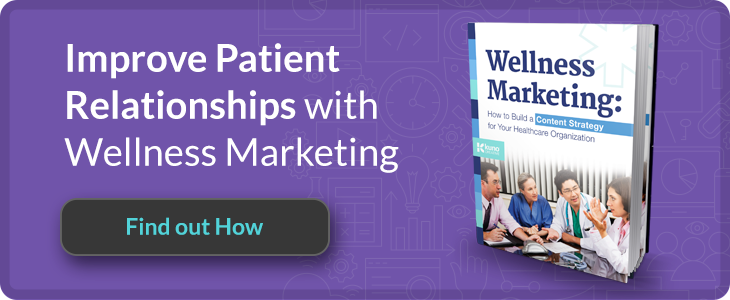
5 Trends that will Transform Healthcare Marketing

Major acquisitions, competitive trends and new consumer preferences and priorities continue to dominate the healthcare industry. While the business model shifts from a fee-for-service model (FFS) to a value-based model, your healthcare marketing plan should reflect the same.
Healthcare providers today are transitioning from curing illness to ensuring wellness, in hopes of encouraging patients to not take healthcare as a once-in-a-blue-moon checkup, but a continuous process that connects them to a doctor or healthcare administrator any time they need it, without even being physically present for it.
The right healthcare marketing strategy means not only staying at the top of your audience’s mind when it comes to opting for a healthcare service but also building the trust that keeps them engaged with you. The following trends allow healthcare marketers to restrategize their take on effectively moving two steps ahead of the competition.
5 Healthcare Marketing Trends
1. Patient Experience and Reputation Management
It’s crucial for your business to collect customer experiences in the form of data and online reviews. Parallel to creating new positive customer experiences, healthcare providers are also collecting past data to review and reverse any negative customer experiences.
According to Think with Google, 77% of patients research online before scheduling an appointment. Their overall online experience helps them decide which healthcare provider to choose, and your website is just the tip of the iceberg. Potential patients go through review sites, social media channels, blogs, etc., before they make a call. This is why your healthcare marketing plan should encompass high-quality content across all platforms. An exemplary online experience results in a high possibility of converting leads into customers.
Implementing Into Your Healthcare Marketing: It’s important that you record all patient responses and that the collective data is analyzed. Use online forms and satisfaction surveys to capture your patients’ experiences. Patient success stories in the form of blogs, videos or even social media posts are a great way to market your business through real-life scenarios. These can add a lot of value to how your potential patients view your healthcare service and associate themselves with you.
2. Patient Convenience and Electronic Tools
Patients want all their healthcare data, and even doctors, at their fingertips. Healthcare organizations are being forced to put aside the old ways where an appointment had to be scheduled weeks in advance and patients had to wait for hours to see a doctor in favor of convenience. And patients today want more than appointment reminders and online scheduling.
It all comes down to digitally connecting patients through a healthcare service. Providers are recognizing the importance of electronic tools and incorporating them with the services they offer their patients. These allow patients the ability to communicate through chatboxes or texting with their service administrator, pay their bills online, and even e-visits. Patients also want visual indicators or graphs of their health progression.
Implementing Into Your Healthcare Marketing: If your healthcare service has invested in digitization for patient convenience, you’ll be at a loss if you don’t promote it. Create videos that explain how your electronic tools can simplify patient-doctor access and communication, write blog posts about the need for digitization in healthcare and provide Q&A that covers common issues for older patients who may be unsure of your devices.
3. SEO and Online Ads
Google’s E-A-T (Expertise, Authority, Trustworthiness) algorithm is only getting smarter, and your healthcare service should make the first cut of search results. When the update first launched, several healthcare businesses took a hit (it was nicknamed the ‘Medic’ update), and businesses are still fighting to keep their necks above water. A good SEO strategy will help potential patients and Google understand your business better. Google’s algorithm ranks you based on the relevance of search terms, frequency of online visits, reviews, uniformity of address, proximity to searcher, etc.
Additionally, there has also been an increase in voice searches. According to TechJury, 58% of consumers use voice search to find local business information, and over one billion voice searches happen per month. This surge creates a need to create content that is SEO-friendly for voice search. These will generally be longer questions and start with keywords such as how, what, where and why.
At the end of 2019, more and more brands are moving into the digital space and the healthcare marketing competition will continue to grow. While SEO is an important part of your healthcare marketing plan, paid advertising has become a necessity to help companies jump ahead of the competition in the search results.
How to Implement Into Your Healthcare Marketing Plan: While most forms of content can help you rank in SEO, blogs and long-form content with industry and geography related high-ranking keywords are one of the quickest ways to rank on top. Voice-related searches in the U.S. are on the rise and creating content that answers voice-search queries can help you stay ahead in SEO.
Utilizing pay-per-click ads on Google is an excellent way of reaching your target audience and potential customers at the right moment. Additionally, placing ads on social media sites, such as Facebook, will provide you with another avenue to reach people who are interested in your content. More than simply “boosting” your best content, you should have a well-thought-out social media marketing strategy to see an actual boost in your ROI.
4. Geofencing
Since most individuals prefer healthcare providers within their actual physical location, geofencing your marketing is a great idea. This allows you to target your mobile ads, blogs, newsletters, etc., to your potential audience, as well as run targeted ads to a specific demographic within your locality. Audit your location listings to ensure accuracy, and add new photos of your location. Include your geographic location in keywords and search terms with identifiers like city or state.
Implementing Into Your Healthcare Marketing: The best way to use geofencing is to post pictures of your locality and include locality-based keywords in blogs and long-forms. Additionally, keep social media updated with your business location, tag your business location in posts, and update your location on Google My Business.
5. Healthcare Apps
Healthcare apps have risen in demand especially after the introduction of smartwatches and fitness monitors. Apps in today’s tech-led world can be created within a few months and at a minimum cost. Use a healthcare app for your business to send push notifications or reminders of upcoming appointments or periodic check-ups. You can store health records and create forums for patients to easily connect with the healthcare provider through messaging or chatboxes. Adding apps to your healthcare marketing strategy can immensely benefit your business and patients.
Implementing Into Your Healthcare Marketing: Developing an app for your healthcare service is not only a step towards digitizing your patient-doctor relations, but also shows your customers that you take their concerns and need for convenience very seriously. Be sure to record every interaction your patient has on the app, whether it’s a virtual check-up or a simple chatbox conversation to see where you can improve.
Revamping Your Healthcare Marketing Approach
The healthcare industry has become as competitive as any other business. Customer experience ranks on top of healthcare priorities, and the change in business models—coupled with new technological advancements in healthcare—means marketers should revamp their approach to reach their target audience. When planning for the months ahead, keep these strategies in mind to stay two steps ahead of the competition.
Joseph Brady is Vice President of Digital Marketing for Reliant Funding, a provider of short-term working capital to small and mid-sized businesses nationwide. He has more than 14 years of experience in B2B digital marketing, optimization, and operations, with a focus on the financial services market.


